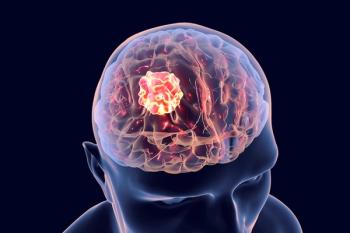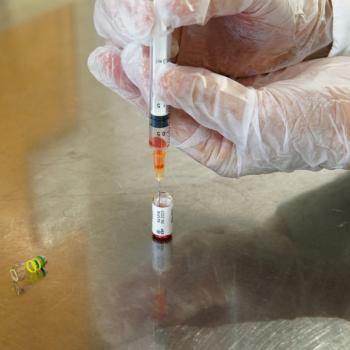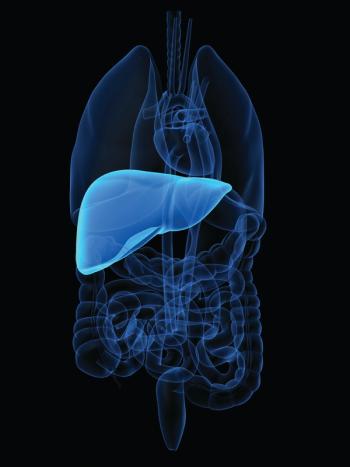
- ONCOLOGY Vol 11 No 9
- Volume 11
- Issue 9
Scientific Basis for the Combination of Tegafur With Uracil
Fujii et al reported that Uracil potentiated the antitumor activity of fluorouracil (5-FU) and 1-(2-tetrahydrofuryl)-5-fluorouracil (tegafur). This effect was due to inhibition of the degradation of 5-FU, yet the phosphorylation of 5-FU was unaffected. The molar ratio of tegafur and uracil was 1:4, a combination that has since been widely prescribed in Japan for the treatment of cancer patients. We present here our experimental and clinical results when investigating the antineoplastic effects of this combination of drugs-known as UFT-and provide evidence that UFT is an effective treatment for patients with cancer. [ONCOLOGY 11(Suppl 10):14-21, 1997]
ABSTRACT: Fujii et al reported that Uracil potentiated the antitumor activity of fluorouracil (5-FU) and 1-(2-tetrahydrofuryl)-5-fluorouracil (tegafur). This effect was due to inhibition of the degradation of 5-FU, yet the phosphorylation of 5-FU was unaffected. The molar ratio of tegafur and uracil was 1:4, a combination that has since been widely prescribed in Japan for the treatment of cancer patients. We present here our experimental and clinical results when investigating the antineoplastic effects of this combination of drugs-known as UFT-and provide evidence that UFT is an effective treatment for patients with cancer. [ONCOLOGY 11(Suppl 10):14-21, 1997]
Fluorouracil (5-FU) and its derivatives have been widely used, either alone, or in combination with other drugs, for the treatment of patients with advanced gastric cancer. However, 5-FU degrades rapidly after coming into contact with dihydrouracil dehydrogenase (EC 1.3.1.2) (mainly produced in the liver) and is subsequently excreted in the urine as a-fluoro-b-alanine.[1] UFT, a combination of 1-(2-tetrahydrofuryl)-5-fluorouracil (tegafur) and uracil at a molar ratio of 1:4 developed by Fujii and colleagues,[2,3] allows for:
- Potentiation of 5-fluorouracils antitumor activity by biochemical modulation.
- High antitumor effect with few side effects due to the tumor selectivity of 5-FU.
- Oral administration for outpatient delivery.
The antineoplastic mechanism of action of UFT is illustrated in Figure 1. Tegafur is metabolized primarily in liver microsomes to 5-FU. 5-FU then undergoes one of two processes: it is either (1) phosphorylated to fluoro-nucleotides, which inhibit RNA and DNA syntheses in tumor cells, or (2) it is degraded to fluoro-ureidopropionic acid and a-fluoro-b-alanine by dihydrouracil dehydrogenase in the liver. The uracil component of UFT inhibits 5-FU degradation, thereby potentiating the antineoplastic pathway. This report describes our experimental and clinical data on the antineoplastic effects of UFT.
The most effective cosubstrate for combination with tegafur was identified by treating sarcoma 180-bearing mice with various doses of tegafur alone or in combination with uracil, uridine, thymine, or thymidine, in a molar ratio of 1:2 (Figure 2).[4] The antineoplastic activity was then assessed, and body weight changes, used as an index of side effects, were examined. Drugs were given orally for 7 days, starting on day 0 of tumor transplantation of sarcoma 180 cells in mice. On day 10, tumor size was measured and tumor/control was examined. Among the nucleosides and bases, uracil best potentiated the antineoplastic effects of tegafur, with limited increase in side effects relative to the other substrates as determined by body weight change, making it the appropriate cosubstrate for tegafur.
The effect of uracil on 5-FU phosphorylation and degradation was examined to determine the combinations antitumor potential (Figure 3).[5] 5-FU phosphorylation was determined, based on the total amount of fluoro-nucleotides in Yoshida sarcoma cells, and its degradation was determined by the total amount of fluoro-ureidopropionic acid and a-fluoro-b-alanine in rat liver slices in vitro. When uracil was administered at different concentrations in medium containing 2.5-mmol/L 5-FU, the phosphorylation of 5-FU was not altered with each concentration, but the degradation of 5-FU did decrease in a dose-dependent manner.
The Michaelis constant of dihydrouracil dehydrogenase was 1.0 × 10-5 mol/L for uracil and 4.0 × 10-5 mol/L for 5-FU, and the Michaelis constant of phosphoribosyltransferase was 9.1 × 10-3 mol/L for uracil and 6.3 ×10-4 mol/L for 5-FU. The Michaelis constant of dihydrouracil dehydrogenase was smaller in uracil than in 5-FU, and that of phosphoribosyltransferase was larger in uracil than in 5-FU. That is, uracil is degraded more and is phosphorylated less, whereas 5-FU is degraded less and is phosphorylated more. The ratio of 5-FU level in the tumor and in the blood, that is, tumor/blood ratio, was examined at 2 and 4 hours after oral coadministration of tegafur 3.0 mg/kg or 7.5 mg/kg, with a different ratio of uracil, to determine the most effective ratio between tegafur and uracil (Figure 4).[3,6] The tumor/blood value was higher in the molar ratio of uracil and tegafur: 4, at both 2 and 4 hours. This molar ratio was thus considered to have a higher tumor specificity with increased antineoplastic activity. This combination was termed UFT.
Deoxythymidine monophosphate (dTMP) synthase activity was determined by a tritium-labeled 5-fluoro-2-deoxyuridylate (FdUMP)-binding assay.[7] Inhibition of dTMP synthase by tegafur, 5-FU, or UFT correlated positively with inhibition of tumor growth by each drug, 4 hours after oral administration of the drug, once on day 10 after sarcoma 180 transplantation to mice (Figure 5).[8] Inhibition of dTMP synthase with UFT 30 mg/kg was prominent compared with those findings with tegafur 30 mg/kg. dTMP synthase inhibition is crucial to the antineoplastic effect of UFT.
Postoperative Chemotherapy
We investigated the effects of mitomycin C (MMC) plus UFT as postoperative therapy for 54 gastrectomized patients with stage IV gastric cancer.[9] These patients were prospectively randomized to one of two regimens (Figure 6): Regimen A consisted of MMC, 20 mg intravenous (IV) injection on the day of operation and 10 mg on day 1 after surgery, and tegafur, 600 mg orally and daily for 2 years, starting 2 weeks after the surgery; regimen B included mitomycin C in the same dose as that of regimen A, and UFT, 600 mg orally and daily for 2 years.
Criteria for patient selection were (1) a histologic diagnosis of gastric cancer; (2) a macroscopic diagnosis of stage IV tumor on completion of the surgical procedure; (3) age under 76 years; (4) no evidence of synchronous or metachronous second cancer; and (5) adequate organ system function (WBC ³ 4,000/mm³, platelets ³ 100,000/mm³, aspartate aminotransferase and alanine aminotransferase less than 100 U, and protein-negative urine). Furthermore, no serious cardiac, renal, or pulmonary complications could be present, and systemic conditions had to be adequate to tolerate the protocol.
Of the 46 (85%) eligible patients, 24 received regimen A and 22 regimen B. There were no significant differences between the two groups with regard to distribution of drug: Mitomycin C 55.8 ± 30.9 mg and tegafur 138.9 ± 120.9 g for regimen A; mitomycin C 58.0 ± 30.5 mg and UFT 129.5 ± 112.1 g for regimen B. There were also no differences between the groups with respect to toxicities. Figure 7 shows survival curves of the 24 patients on regimen A and 22 patients on regimen B. At the time of this analysis, the median follow-up for the eight survivors was 4.98 years, and 38 (83%) of the 46 patients had died. The 5-year survival rate was higher for those on regimen B than those on regimen A (P < .05). We found that UFT, compared with tegafur, lengthened survival time of patients with stage IV gastric cancer approximately twofold. Rates of side effects were not increased by giving a daily dose UFT, because UFT is selectively toxic against tumor tissue. Mitomycin C plus UFT shows promise in the treatment of patients with stage IV gastric cancer. A retrospective analysis proved this protocol to be effective for patients with gastric cancer of the poorly differentiated tissue type, but not that of the well-differentiated type.
Next, we prospectively evaluated the effective postoperative dose of UFT for patients with poorly differentiated gastric cancer following curative resection.[10] Patients were prospectively randomized immediately after surgery to one of two treatment groups by the referring center (Figure 8). In group A patients received induction therapy with mitomycin C 20 mg IV injection on the day of surgery followed on postoperative day 1 by 10 mg IV. As maintenance therapy, patients in group A received daily oral UFT (combination tegafur/uracil in a molar ratio of 1:4) 8 mg/kg (tegafur), as well as daily oral administration of PSK (Kreha Chemical Industry Co., Ltd., Japan) 3 g beginning 2 weeks post-surgery for 1 year. PSK is a protein-bound polysaccharide preparation extracted from Basidiomycete. Patients in treatment group B received a higher dose of daily UFT (12 mg/kg tegafur) but via the same protocol for Mitomycin C and PSK as used in regimen A.
Patient eligibility was determined on the basis of (1) a histologic diagnosis of poorly differentiated gastric cancer by preoperative biopsy; (2) macroscopic diagnosis of a curative resection and stage II-IV, on completion of all surgical procedures; (3) age under 76 years; (4) performance status grade 0-2; (5) no second previous or concurrent primary malignancies in any other organ; (6) adequate organ system function (leukocytes greater than 4,000/mm³ platelet greater than 100,000/mm³, aspartate aminotransferase and alanine aminotransferase less than 100 U).
A total of 224 patients entered the study, of whom 196 (87.5%) were eligible for evaluation: 100 in group A and 96 in group B. No differences were observed in prognostic factors, toxicity rate, or the doses of the drugs prescribed, except for UFT (Table 1, Table 2, and Table 3). Figure 9 indicates that the cause-specific survival curves were significantly different between the eligible patients in groups A and B (P < .05). The 5-year survival rate was 58.6% for group A and 69.4% for group B. Data on patients who underwent curative resection were histologically examined for the rate and type of recurrence. The rate of recurrence decreased in group B compared with that of group A (P < .05). In particular, the rate of peritoneal recurrence was lower and the estimated cumulative frequency of isolated peritoneal recurrence at 5 years was 37.0% in group A and 19.4% in group B, and the difference was statistically significant (P < .05) (Figure 10). UFT at 12 mg/kg for postoperative chemotherapy is thus considered to improve postoperative results with no increased toxicity among patients with a poorly differentiated gastric cancer.
Malabsorption of nutrients can occur after gastrectomy, the cause being rapid intestinal transit, bacterial overgrowth and/or pancreatic understimulation. Following the oral administration of 200 mg UFT to patients with macroscopic stage I gastric cancer, we examined the concentrations of these drugs in blood samples on the day prior to surgery and at 2 weeks and 3 months postoperatively.[11] Seventeen patients underwent partial gastrectomy (nine cases of Billroth I reconstruction, eight cases of Billroth II reconstruction), and nine patients underwent total gastrectomy with modified Roux-en-Y reconstruction (Figure 11). Before surgery, the area under the curve (AUC) for tegafur, uracil, and 5-FU was 79.28 ±; 26.88, 4.41 ± 1.78, and 0.51 ± 0.20 µg · h/mL-1, respectively. Partial (Billroth I and II) and total gastrectomy did not alter the AUC of tegafur, and partial gastrectomy using Billroth I and II methods decreased the AUCs of uracil and 5-FU during the first 2 weeks postoperatively. However, plasma levels of uracil and 5-FU reverted to preoperative values at 3 months after the surgery.
Tegafur was developed as a lipophilic masked derivative of 5-FU so as to improve the absorbability and to retain the antitumor effect after oral ingestion; it is absorbed by passive diffusion from the intestine.[12,13] Anttila and colleagues[14] reported that tegafur is well absorbed from the intestine, is distributed into each organ in patients with a nonresectable hepatic tumor, and there is no need to give this drug intravenously. In case of uracil, active transport is the predominant mode of absorption, and passive diffusion occurs when the concentration of uracil in the small intestine is increased and active processes are saturated.
The peak concentration was decreased and the peak time was delayed for both tegafur and uracil in patients undergoing partial gastrectomy because of diminished movement of the remnant stomach and a lower degree of transit of these agents in the time trend from the remnant stomach to the small intestine during the early postoperative period. On the other hand, the liver is the main organ in which drugs are metabolized.[15] As no changes were noted in perioperative liver and renal functions, there should be no difference in the rate of drug metabolism measured on the day before the operation and that determined postoperatively. Therefore, in cases of partial gastrectomy, the absorption of water-soluble uracil in the small intestine would be decreased and the level of AUC would be lower. As uracil suppresses the degradation of 5-FU in the liver of patients, the lower absorption of uracil in cases of partial gastrectomy is closely related to the lower plasma level of 5-FU. In cases of total gastrectomy, tegafur and uracil are immediately transferred to the intestine after oral ingestion of UFT and are well absorbed. The minimal inhibitory concentration of 5-FU has been reported to be 0.05 µg/mL[16,17] both experimentally and clinically; however, the peak concentration of 5-FU was lower than this concentration following the administration of 200 mg UFT after partial gastrectomy with Billroth I reconstruction. When the oral prescription of UFT was continued, 5-FU accumulated and the blood level of 5-FU exceeded 0.5 µg/mL. As the cytotoxicity of 5-FU is also dose-dependent, the antineoplastic effect of UFT should be lower in cases of partial gastrectomy when the preparation is prescribed during the early postoperative period. The decreased absorption of uracil was overcome within 3 months postoperatively, and functions of the digestive organs recovered to normal levels. Thus, partial gastrectomy with Billroth I and II reconstruction alters the pharmacokinetics of UFT following oral ingestion.
Combined effects of uracil and tegafur were examined, under both experimental and clinical situations. Tegafur combined with uracil elicited a selective antineoplastic effect. Biochemical modulation by uracil specifically enhances 5-FU concentrations in gastric tumor tissues. UFT is considered effective for patients with gastric cancer, in a postoperative setting.
References:
1. Toide H, Akiyoshi H, Minato Y, et al: Comparative studies on the metabolism of 1-(2-tetrahydrofuryl)-5-fluorouracil and 5-fluorouracil. Gann 68:553-560, 1977.
2. Fujii S, Ikenaka K, Fukushima M, et al: Effect of uracil and its derivatives on antitumor activity of 5-fluorouracil and 1-(2-tetrahydrofuryl)-5-fluorouracil. Gann 69:763-772, 1978.
3. Fujii S, Kitano S, Ikenaka K, et al: Effect of coadministration of uracil or cytosine on the antitumor activity of clinical doses of 1- (2-tetrahydrofuryl)-5-fluorouracil and level of 5-fluorouracil in rodents. Gann 70:209-214, 1979.
4. Fujii S, Kitano S, Ikenaka K, et al: Coadministration of thymidine or thymine on antitumor activity of FT-207 or 5-fluorouracil (in Japanese). Jpn J Cancer Chemother 6:1097-1103, 1979.
5. Ikenaka K, Shirasaka T, Kitano S, et al: Effect of uracil on metabolism of 5-fluorouracil in vitro. Gann 70:353-359, 1979.
6. Fujii S, Kitano S, Ikenaka K, et al: Studies on coadministration of uracil or cytosine on antitumor activity of FT-207 or 5-FU derivatives (in Japanese). Jpn J Cancer Chemother 6:377-384, 1979.
7. Spears CP, Shahinian AH, Moran RG, et al: In vivo kinetics of thymidylate synthetase inhibition in 5-fluorouracil-sensitive and -resistant murine colon adenocarcinomas. Cancer Res 42:450-456, 1982.
8. Nakamura H, Yu-Qin W, Miyauchi S, et al: Studies on the mechanism of antitumor activity of 5-FU and its derivatives: Relationship between the inhibition of tumor growth and the inhibition of thymidylate synthase in vivo (in Japanese). Jpn J Cancer Chemother 11:1049-1055, 1984.
9. Maehara Y, Watanabe A, Kakeji Y, et al: Postgastrectomy prescription of mitomycin C and UFT for patients with stage IV gastric carcinoma. Am J Surg 160:242-244, 1990.
10. Sugimachi K, Maehara Y, Ogawa M, et al: Dose intensity of uracil and tegafur in postoperative chemotherapy for patients with poorly differentiated gastric cancer. Cancer Chemother Pharmacol, 40:233-238, 1997.
11. Maehara Y, Takeuchi H, Oshiro T, et al: Effect of gastrectomy on the pharmacokinetics of tegafur, uracil, and 5-fluorouracil after oral administration of a 1:4 tegafur and uracil combination. Cancer Chemother Pharmacol 33:445-449, 1994.
12. Sasaki H, Nakamura J, Konishi R, et al: Intestinal absorption characteristics of 5-fluorouracil, ftorafur and 6-mercaptopurine in rats. Chem Pharm Bull 34:4265-4272, 1986.
13. Bronk JR, Lister N, Lynch S: Absorption of 5-fluorouracil and related pyrimidines in rat small intestine. Clin Sci 72:705-716, 1987.
14. Anttila MI, Sotaniemi EA, Kairaluoma MI, et al: Pharmacokinetics of Ftorafur after intravenous and oral administration. Cancer Chemother Pharmacol 10:150-153, 1983.
15. Maehara Y, Nagayama S, Okazaki H, et al: Metabolism of 5-fluorouracil in various human normal and tumor tissues. Gann 72:824-827, 1981.
16. Kimura K, Suga S, Shikaji T, et al: Clinical basis of chemotherapy for gastric cancer with uracil and 1-(2-tetrahydrofuryl)-5-fluorouracil. Gastroenterol Jpn 15:324-329, 1980.
17. Suga S, Kimura K, Yokoyama Y, et al: Studies on the designing of chemotherapy for gastric cancer in man, based on the tumor tissue concentration of anticancer agents. Gastroenterol Jpn 17:295-300, 1982.
Articles in this issue
about 28 years ago
UFT: East Meets West in Drug Developmentabout 28 years ago
Rationale for Phase I Study of UFT Plus Leucovorin and Oral JM-216about 28 years ago
Postoperative Adjuvant Chemotherapy for Non-Small-Cell Lung Cancerabout 28 years ago
UFT in Gastric Cancer: Current Status and Future Developmentsabout 28 years ago
Oral UFT and Leucovorin in Patients With Advanced Gastric CarcinomaNewsletter
Stay up to date on recent advances in the multidisciplinary approach to cancer.


















































































